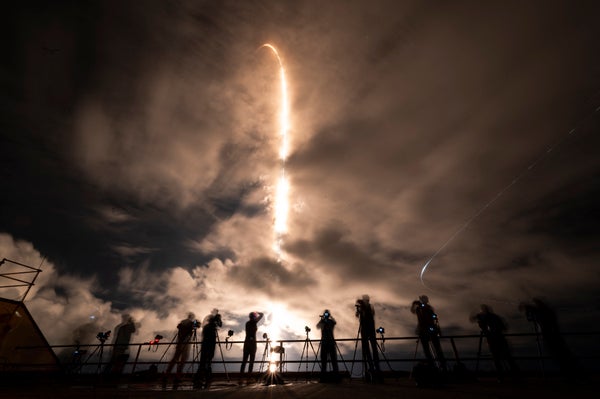Polaris Dawn Astronauts Launch on Daring Private Mission

September 10, 2024
4 min read
Polaris Dawn Astronauts Launch on Daring Private Mission
Polaris Dawn’s astronauts will travel farther from Earth than anyone since the early 1970s and will attempt the world’s first private spacewalk
Riding in a SpaceX Crew Dragon capsule atop one of the company’s Falcon 9 rockets, the crew of the Polaris Dawn mission soars above NASA’s Kennedy Space Center in Cape Canaveral, Florida during an early-morning launch on September 10, 2024.
Chandan Khanna/AFP via Getty Images
The four-person Polaris Dawn mission launched early this morning (Sept. 10), with the goal of making some spaceflight history.
Polaris Dawn, which aims to conduct the first-ever private spacewalk, lifted off atop a SpaceX Falcon 9 rocket today at 5:23 a.m. EDT (0923 GMT) from historic Launch Complex-39A at NASA’s Kennedy Space Center (KSC). Pad 39A also hosted most of NASA’s Apollo moon launches, which were the last crewed missions to fly as far as the Polaris Dawn astronauts will travel.
Roaring off the launch pad, the rocket’s nine Merlin engines cast a blisteringly bright light on the still waters around KSC, climbing into the sky until the glow of the engines faded into the sky as another shimmering point among the stars.
On supporting science journalism
If you’re enjoying this article, consider supporting our award-winning journalism by subscribing. By purchasing a subscription you are helping to ensure the future of impactful stories about the discoveries and ideas shaping our world today.
The launch was originally supposed to occur on Aug. 26, but SpaceX stood down from that attempt to perform more preflight checks. A try the following day was nixed after the mission team detected a helium leak in the equipment supporting the Falcon 9. The liftoff was then delayed multiple times by bad weather, before Mother Nature finally relented today.
About two minutes and 40 seconds into the launch, the Falcon 9’s main engines cut off, and the booster separated from the second stage as planned. The booster then performed a series of burns to align its return trajectory with the SpaceX autonomous droneship Just Read the Instructions, which was stationed in the Atlantic Ocean. Approximately 9.5 minutes after liftoff, the rocket touched down on the barge off Florida’s eastern coast.
Polaris Dawn’s Crew Dragon spacecraft separated from the Falcon 9’s upper stage a little over 12 minutes after launch.
“We wouldn’t be on this journey without all 14,000 of you back home and everyone else cheering us on,” billionaire entrepreneur Jared Isaacman, who commands and funds Polaris Dawn, told SpaceX mission control shortly after Crew Dragon deployed into orbit. “We appreciate it. We’re gonna get to work now.”
The capsule settled into an initial elliptical orbit with a maximum altitude (apogee) of about 745 miles (1,200 kilometers), with the minimum altitude (perigee) holding at about 118 miles (190 km). After a few orbits, Crew Dragon will raise its apogee to about 870 miles (1,400 km) — higher than any human has flown since the final Apollo mission in 1972.
Isaacman has been to space once before. He also funded and commanded SpaceX’s Inspiration4 mission in September 2021, which raised $250 million for St. Jude Children’s Research Hospital in Memphis, Tennessee. Isaacman hopes this mission can build on that momentum.
He is joined on Polaris Dawn by the first two SpaceX employees to launch to orbit, mission specialists Sarah Gillis and Anna Menon, as well as retired U.S. Air Force Lt. Col. Scott “Kidd” Poteet, who serves as mission pilot. The quartet will spend the next five days in space, completing a few dozen experiments in the novel space environment that the mission is exploring.
After Polaris Dawn’s second day in space, Dragon will lower its apogee to about 435 miles (700 km), where it will remain until its deorbit burn and return to Earth. At this altitude, the Polaris Dawn crew will conduct the most critical part of its mission: history’s first commercial spacewalk.
The EVA (extravehicular activity) will take place on the third day of the mission. A chief goal of the operation is to test out SpaceX’s new EVA spacesuit, which is visually similar to the company’s familiar black-and-white IVA (intravehicular activity) suit, which is worn only inside the spacecraft.
Crew Dragon doesn’t have an airlock, so the capsule’s entire interior will be exposed to the vacuum of space during the EVA. All four Polaris Dawn crewmembers will therefore suit up during the spacewalk, though only Isaacman and Gillis will venture outside the spacecraft.
The duo will take turns exiting Crew Dragon to test the functionality and maneuverability of their suits. In total, the Polaris Dawn EVA will last about two hours from the start of Crew Dragon’s depressurization until the hatch is closed and the cabin repressurized.
The mission’s fourth day includes a Starlink demonstration; the Polaris Dawn crew has teased an exciting surprise message they intend to transmit down to Earth via SpaceX’s megaconstellation of internet satellites.
Day five of Polaris Dawn will be spent preparing for the return journey home, provided all the other mission goals have been achieved by this point. (The crewmembers will also conduct about 40 science experiments during the mission.)
Polaris Dawn’s Dragon is expected to splash down six days after liftoff, performing a final series of deorbit burns on a return trajectory for terra firma. If everything goes according to plan, the Polaris Dawn crew will parachute into the ocean in one of a handful of potential landing zones off the coast of Florida, where a recovery ship will retrieve the spacecraft and crew.
Copyright 2024 Space.com, a Future company. All rights reserved. This material may not be published, broadcast, rewritten or redistributed.